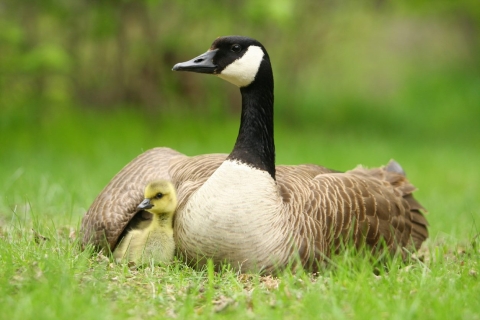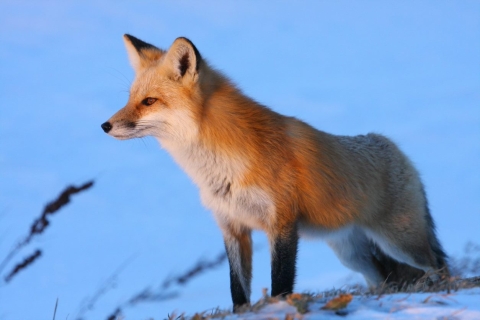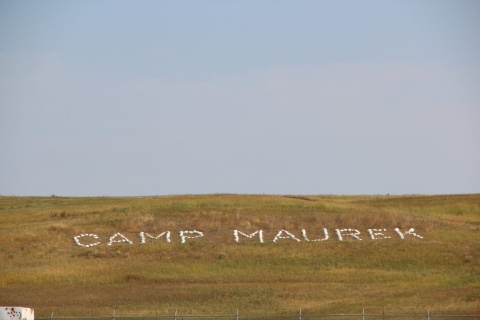About Us
Upper Souris National Wildlife Refuge is one of over 565 refuges and 38 wetland management districts in the National Wildlife Refuge System - a network of lands set aside and managed by the U.S. Fish and Wildlife Service specifically for wildlife. The Refuge System is a living heritage, conserving wildlife and habitat for people today and generations to come.
Upper Souris National Wildlife Refuge lies in the beautiful Souris River Valley of northwestern North Dakota and extends for 35 miles along the Souris River corridor. This Refuge, managed by the U.S. Fish and Wildlife Service, is an important unit in a series of national wildlife refuges in the waterfowl migration corridor known as the Central Flyway.
The purpose for establishing the Refuge in 1935 was "...as a refuge and breeding ground for migratory birds and other wildlife..."
The Refuge habitat is managed for diversity to provide the life requirements of all wildlife. Grasslands are periodically grazed, hayed, burned and rested to provide good nesting and escape cover for wildlife and to rejuvenate the vegetation.
Lake Darling, a 9,600-acre lake named in honor of Ding Darling, is the largest of several water impoundments on the Refuge. Its primary purpose is to furnish a regulated supply of water to smaller marshes downstream and especially to the larger marshes on the J. Clark Salyer Refuge, 110 miles downstream. The lake is designed to hold a two-year supply of water to safeguard marshes downstream against the threat of drought. The dam also makes it possible to reduce the flooding and to regulate releases during periods of low flow. Both operations benefit people in the valley below the dam.
The proper management of water permits an active fisheries program on the Refuge. This is a cooperative effort between the Refuge and the Missouri River Fish and Wildlife Management Assistance Office. Northern pike, walleye, yellow perch, and smallmouth bass may be caught in Lake Darling and the Souris River.
One successful Refuge management program has been the re-establishment of a resident Canada goose flock. These magnificent birds were once common, but they gradually disappeared with loss of habitat due to change in land use. The first "honkers" were reintroduced in 1940 and the flock has continued to grow into a healthy, stable population.
Our Mission
Each unit of the National Wildlife Refuge System is established to serve a statutory purpose that targets the conservation of native species dependent on its lands and waters. All activities on those acres are reviewed for compatibility with this statutory purpose.
The purpose for establishing the Refuge in 1935 was "...as a refuge and breeding ground for migratory birds and other wildlife..."
The Souris River basin figures prominently in the culture and natural history of midcontinent North America’s plains and prairies. As one of three National Wildlife Refuges of the Souris River basin, The Upper Souris National Wildlife Refuge will enhance populations of migratory birds, including waterfowl, and other wildlife native to the landscape by conserving the ecology and the natural character of the northern plains region.
The Refuge will create a sense of awe and wonder by providing an array of wildlife-dependent recreational and educational experiences that enhance visitor awareness of the splendid natural and cultural heritage of the northern great plains.
Functioning as integral parts of the ecosystems and human communities to which they belong, the Refuge staff will seek collaborative partnerships to attain common goals.
A diverse and passionate Refuge workforce will rely on sound science to understand and restore or emulate natural processes essential to the integrity and perpetuation of major biological communities with which the Refuge is entrusted.
Our History
In the 1930s, drought brought the dust bowl to the Great Plains. The drought dried out the land, and the wind covered everything with dust. As the water levels dropped in the region, many wetlands dried out, and duck populations plummeted to all-time lows. Conservationists began to act to reverse this trend.
In 1934, a political cartoonist from Iowa, J.N. “Ding” Darling, became Director of the newly formed Bureau of Biological Survey. Darling helped push the Migratory Bird Hunting Stamp Act through Congress in 1934. Commonly referred to as the “Duck Stamp Act,” this Act requires every waterfowl hunter 16 years and older to purchase a Federal duck stamp. Proceeds from duck stamp sales are used to buy and lease waterfowl habitat.
In 1935, J. Clark Salyer, “Ding” Darling’s top aide, used duck stamp money to help purchase three refuges on the Souris River, including Upper Souris Migratory Waterfowl Refuge. The Refuge was established by Executive Order on August 27, 1935, by President Franklin D. Roosevelt “... as a refuge and breeding ground for migratory birds and other wildlife...”
Civilian Conservation Corps
From 1935 to 1941, the Civilian Conservation Corps and Works Project Administration provided large labor forces who built dikes, roads, fences, and water control structures on the Refuge. Camp Maurek, a military-style camp located southeast of Lake Darling Dam, housed as many as 250 men. Members of Camp Heintzelman, located in Mohall, developed wildlife habitat and facilities on the north end of the Refuge.


